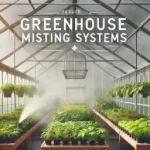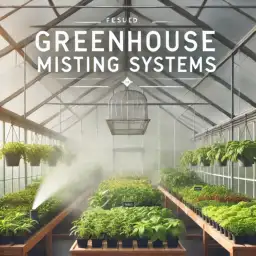Greenhouse misting systems are very important for modern gardening and farming. These systems help control the environment inside a greenhouse and ensure the best conditions for plant growth. They can control temperature, maintain humidity levels, and reduce plant stress by spraying a fine water mist. This guide will explain how misting systems work and their benefits, types, maintenance, and costs.
What is a Greenhouse Misting System?
A misting system sprays tiny drops of water inside, like a little rain cloud. This makes the air good for plants.
How Does a Greenhouse Misting System Work?

A greenhouse misting system helps plants grow by keeping the air cool and moist. This system is very helpful for plants that need the right temperature and humidity to stay healthy.
How It Works
- Spray: Water goes through tiny nozzles.
- Cool Air: The water makes the air cool.
- More Wet Air: The air gets more wet. Plants love this!
- You Control It: You can turn it on and off.
Maintenance of Greenhouse Misting Systems

So, you have a misting system. Great! But like a little plant, it needs care—actually, lots of care. Let’s keep it happy.
Checking Nozzles
- Do this: Check the little nozzles—a lot—to make sure they aren’t blocked and clean them well. You want a nice, fine mist, right?
- Why it matters: Blocked nozzles = bad mist. Bad mist = sad plants.
Inspecting Water Lines
- Do this: Look at the water lines. Any leaks? Any blocks? Fix them fast!
- Why it matters: Leaks wastewater. Blocks stop the mist. Needs improvement!
Monitoring Water Quality
- Do this: Use good water. Filtered is best. Check the water. Clean the system.
- Why it matters: Bad water makes yucky clogs. Yucky clogs = broken mister.
Regular System Checks
- Do this: Look at the whole thing. Does anything look bad or broken? Fix it!
- Why it matters: Happy mister = long life. And happy plants!
Cost Implications of Greenhouse Misting Systems

So, you want a misting system? Right on! But how much will it cost? Let’s break it down—it’s super simple.
Initial Costs
- Building the Greenhouse: You’ve got to have walls and a roof, right? Glass, plastic, metal—it adds up. A bigger greenhouse means bigger bucks.
- Misting Stuff: Nozzles, pipes, and pumps. And someone to put it all together. Good work isn’t free.
- Goin’ Organic?: Organic dirt and plant food can cost more. But, hey, healthy plants!
- Water Works: Need water for mist, right? A good watering system costs money, too.
Ongoing Costs
- People Power: Someone has got to check the misters. Make sure they work. Time is money, friend.
- Electric Bill: Misters need power. Power costs money. It’s as simple as that.
- Fixing Stuff: Things break. Nozzles clog. Have got to fix ‘them—more money.
How to Choose the Right Greenhouse Misting System

Okay, so what kind of misters do you need?
Greenhouse Size:
- Small Greenhouse: Little misters are fine. It’s cheaper and easier.
- Big Greenhouse: Need big misters. They cost more, but they work better in big spaces.
Plant Types:
- Sensitive Plants: Gentle mist, like fog.
- Tough Plants: Regular mist is okay.
Budget Considerations:
- Money Thing Big Misters Little Misters First Cost Lots of money, not so much money
- fixing Stuff Cost Can be lots of money not usually so much money
And, yeah, that’s it. Picking the right misters depends on your greenhouse, plants, and wallet. Easy peasy, right?
Environmental Impact of Greenhouse Misting Systems
Misting systems are good for plants and the Earth. They help us save water and use less power. And they can even help us use fewer bug sprays!
Saving Water is Cool
- How it Works: Mist gives water right to the plants.
- Why it’s Great: No wasted water! Plants get just what they need.
Bugs Don’t Like Mist!
- How it Works: Lots of mist makes the air wet. Bugs don’t like that!
- Why it’s Great: Less bug spray! Good for the Earth.
Misting Uses Less Power
- How it Works: Misting uses less power than big air coolers.
- Why it’s Great: Saves power! Good for the Earth.
Common Problems and How to Avoid Them
Here are some common issues and how to avoid them.
Sometimes, things need to be corrected. But don’t worry! Easy fixes!
Problem
Clogged Nozzles (No mist!)
- Clean them!
- Use clean water.
Leaky Pipes (Drippy pipes!)
- Look for leaks.
- Fix them fast!
Not Enough Mist (Plants are dry!)
- Check the settings.
- Fix the mister.
Weak Water (Not enough oomph!)
- Check the water.
- Clean the pump.
Hard Water Stuff (White stuff in the pipes!)
- Use soft water.
- Clean the pipes!
Electric Zap! (Mister not working!)
- Check the wires.
- Get help from someone who knows!
Benefits of Using a Misting System in a Greenhouse
Greenhouse misting systems offer several advantages.
Key Benefits
- Not Too Hot: Misting cools the air, so plants don’t get too hot—like a little air conditioner!
- More Wet Air: Plants like wet air. Misting makes the air wet, so plants are happy. And they grow big and strong!
- Happy Plants: Happy plants don’t get sick. They grow and grow!
- No Bugs! Wet air keeps bugs away! No bad bugs!
- Saves Money: Misting doesn’t use lots of power. Less power, more money saved!
Misting is super good for plants. It helps them grow big and strong.
Types of Greenhouse Misting Systems

There are various types of misting systems available for greenhouses.
So, there are lots of ways to mist.
High-Pressure:
- How it works: Shoots water fast! Makes a tiny mist. Like a cloud!
- Good Stuff: Makes big places cool. Uses less water. Good for big greenhouses.
Low-Pressure:
- How it works: Water goes slow. Makes bigger drops. Not like a cloud.
- Good stuff: Easy and a little money. Good for little greenhouses.
Fogging:
- How it works: It makes a big fog! Like a spooky house! But good for plants!
- Good stuff: It makes everything wet. It is good for plants that like lots and lots of damp air.
Greenhouse misting systems are good if you like plants. They help keep them cool and not too dry, so your Plants will be happy and healthy. And they don’t use lots of power!
There are lots of ways to mist! Big misting, Little misting. Something for everyone!
Take care of your mister. And know how much it will cost. Then your plants will be super happy!
So, get a mister. Your plants will love you!














